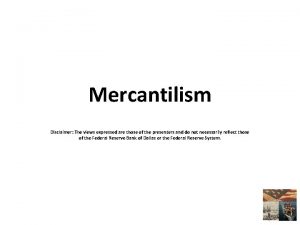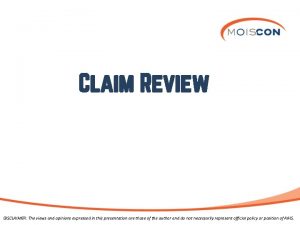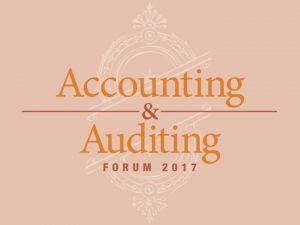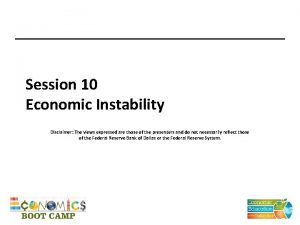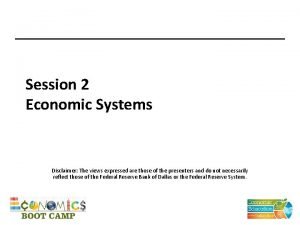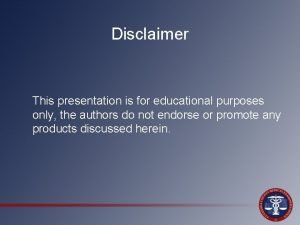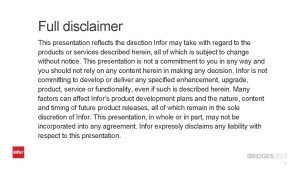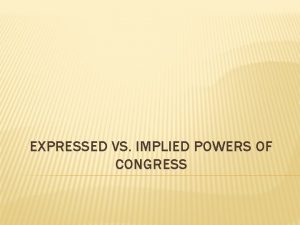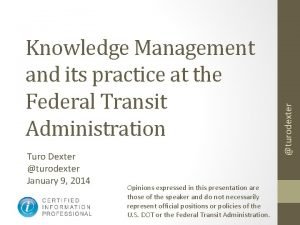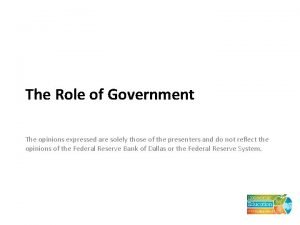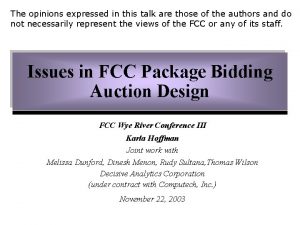Disclaimer The opinions expressed in this presentation are










![Delivering the Message [T]he agencies expect that smaller and less complex institutions will be Delivering the Message [T]he agencies expect that smaller and less complex institutions will be](https://slidetodoc.com/presentation_image_h/b6f9dad7d3509601297e5981546d6285/image-11.jpg)





























- Slides: 40


Disclaimer The opinions expressed in this presentation are intended for informational purposes and are not formal opinions of, nor binding on, the Board of Governors of the Federal Reserve System or the Federal Reserve Bank of Kansas City.

The CECL Model: Where Things Stand Paul Oseland, CPA Accounting Specialist Federal Reserve Bank of Kansas City

Issued Guidance • ASU 2016 -13, “Measurement of Credit Losses on Financial Instruments” – Issued June 16, 2016 • Joint Statement on the New Accounting Standard on Financial Instruments – Credit Losses – SR 16 -12 issued June 17, 2016 • Frequently Asked Questions on the New Accounting Standard on Financial Instruments – Credit Losses – SR 17 -8 issued September 6, 2017 (updates SR 16 -19)

Digesting ASU 2016 -13

CECL Effective Dates * For institutions with calendar year ends. ** A public business entity that is not an SEC filer would include (1) an entity that has issued securities that are traded, listed, or quoted on an over-the-counter market, and (2) an entity that has issued one or more securities that are not subject to contractual restrictions on transfer and is required by law, contract, or regulation to prepare U. S. GAAP financial statements and make them publicly available periodically (e. g. , pursuant to Section 36 of the Federal Deposit Insurance Act and Part 363 of the FDIC’s regulations).

CECL – Core Principles • “The allowance for credit losses is a valuation account that is deducted from the amortized cost basis of the financial asset(s) to present the net amount expected to be collected on the financial asset. ” – ASC 326 -20 -30 -1 • “An entity shall estimate expected credit losses over the contractual term of the financial asset(s)…” – ASC 326 -20 -30 -6

Core Principles • “Historical credit loss experience of financial assets with similar risk characteristics generally provides a basis for an entity’s assessment of expected credit losses. ” – ASC 326 -20 -30 -8 • “… shall consider the need to adjust historical information to reflect the extent to which management expects current conditions and reasonable and supportable forecasts to differ from the conditions that existed for the period over which historical information was evaluated. ” – ASC 326 -20 -30 -9

Core Principles (cont. ) • “Estimating expected credit losses is highly judgmental and generally will require an entity to make specific judgments” – ASC 326 -20 -55 -6 • “Because of the subjective nature of the estimate, this Subtopic does not require specific approaches when developing the estimate of expected credit losses” – ASC 326 -20 -55 -7

Components of the CECL Calculation Unadjusted historical lifetime loss experience Adjustments for past events and current conditions Adjustments for reasonable and supportable forecasts CECL credit losses Substantial additional components required under the CECL model: • Lifetime historical loss experience vs. annual or loss emersion period • Incorporation of reasonable and supportable forecasts
![Delivering the Message The agencies expect that smaller and less complex institutions will be Delivering the Message [T]he agencies expect that smaller and less complex institutions will be](https://slidetodoc.com/presentation_image_h/b6f9dad7d3509601297e5981546d6285/image-11.jpg)
Delivering the Message [T]he agencies expect that smaller and less complex institutions will be able to adjust their existing allowance methods to meet the requirements of the new accounting standard without the use of costly and/or complex modeling techniques. – FAQs on CECL, question #7

Delivering the Message (cont. ) Although the new accounting standard provides examples of similar risk characteristics, smaller and less complex institutions may conclude that the segmentation practices they have used under the incurred loss methodology are also appropriate under the expected loss methodology, or they may refine those practices. – FAQs on CECL, question #8

Delivering the Message (cont. ) The agencies will not require institutions to engage third-party service providers to assist management in calculating allowances for credit losses under CECL. If an institution chooses to use a third-party service provider to assist management with this process, the institution should follow the agencies’ guidance on third-party service providers. – FAQs on CECL, question #16

Delivering the Message (cont. ) An institution should collect and maintain data relevant to estimating lifetime expected credit losses that align with each method the institution will use to estimate its allowances for credit losses under CECL. The agencies encourage institutions to discuss the availability of historical loss data internally with lending, credit risk management, information technology, and other functional areas and with their core loan service providers. – FAQs on CECL, question #25

Data Collection To plan and prepare for the transition to and implementation of the new accounting standard, each institution is encouraged to identify currently available data that should be maintained and consider whether any additional data may need to be collected or maintained to implement CECL. Examples of types of data that may be needed to implement CECL include: - FAQs on CECL, number 22

Delivering the Message (cont. ) The agencies expect supervised institutions to make good faith efforts to implement the new accounting standard in a sound and reasonable manner. After the effective date of CECL, the agencies will assess the implementation of the accounting standard and consider the need to issue additional supervisory guidance to aid in the development of practices for the sound application of the standard. – FAQs on CECL, question #7

Supervisory Approach

Other CECL Issues

Other CECL Issues (cont. ) • The agencies will not require institutions to reconstruct data from earlier periods that are not reasonably available • Qualitative factors are still relevant under CECL • Institutions can not build their allowance levels in anticipation of adopting CECL • The agencies will not establish benchmarks or floors for allowance levels under CECL • The agencies will continue to examine the ALLL using examination procedures applicable to ensuring compliance with an incurred credit loss methodology consistent with existing U. S. GAAP

Cleanse the Palate The opinions expressed in this presentation are intended for informational purposes and are not, UNDER ANY CIRCUMSTANCES, formal opinions of, nor binding on, the Board of Governors of the Federal Reserve System or the Federal Reserve Bank of Kansas City. Seriously.

Examples of The Calculation of Expected Credit Losses Under CECL

Look How Simple It Is! A valuation account Deducted from amortized cost basis of financial assets Used to present “net amount expected to be collected” Changes flow through net income Book the difference as CECL allowance Amortized cost: Unpaid principal balance lent to a customer adjusted for loan fees and origination expenses, repayments, write-offs, nonaccrual practices, and certain hedging transactions Amount expected to be collected: Remaining amounts expected to be collected from each loan

Simple Incurred Loss ALLL Calculation • For the smaller, noncomplex banks it is not uncommon for the allowance to be calculated on an Excel spreadsheet that has 5 sections – – – Part 1: Impaired Loans (ASC 450 / FAS 114) Part 2: Historical Loss Rate Calculation Part 3: Qualitative factors Part 4: Historical Rate Loan Losses (ASC 310/ FAS 5) Part 5: Summary of Calculation

Part 1: Impaired Loans Loan Number Balance Collateral Value Impairment 359452 $45, 000 $40, 000 $5, 000 249846 $120, 000 $190, 000 $0 216747 $5, 000 639181 $12, 000 $6, 000 478435 $57, 000 $75, 000 $0 913456 $25, 000 $20, 000 $5, 000 654611 $85, 000 $75, 000 $10, 000 646184 $175, 000 $225, 000 $0 745461 $30, 000 $27, 000 $3, 000 488341 $215, 000 $175, 000 $40, 000 $769, 000 Total impairment per ASC 450 / FAS 115 $74, 000

Part 2: Historical Loss Calculation Residential RE Consumer Commercial RE C&I Agricultural 2012 Portfolio Balance Charge-offs Recoveries Net Charge-offs Annual Loss Rate $25, 000 ($115, 000) $50, 000 ($65, 000) 0. 26% $27, 000 ($175, 000) $15, 000 ($160, 000) 0. 59% $122, 000 ($600, 000) $68, 000 ($532, 000) 0. 44% $98, 000 ($775, 000) $190, 000 ($585, 000) 0. 60% $5, 000 $0 $0 $0 0. 00% Portfolio Balance Charge-offs Recoveries Net Charge-offs Annual Loss Rate $27, 000 ($75, 000) $50, 000 ($25, 000) 0. 09% $25, 000 ($145, 000) $25, 000 ($120, 000) 0. 48% $135, 000 ($510, 000) $120, 000 ($390, 000) 0. 29% $105, 000 ($835, 000) $255, 000 ($580, 000) 0. 55% $4, 100, 000 ($35, 000) $0 ($35, 000) 0. 85% Portfolio Balance Charge-offs Recoveries Net Charge-offs Annual Loss Rate $29, 000 ($110, 000) $20, 000 ($90, 000) 0. 31% $28, 000 ($180, 000) $15, 000 ($165, 000) 0. 59% $140, 000 ($415, 000) $75, 000 ($340, 000) 0. 24% $110, 000 ($590, 000) $25, 000 ($565, 000) 0. 51% $4, 500, 000 $0 $15, 000 -0. 33% Portfolio Balance Charge-offs Recoveries Net Charge-offs Annual Loss Rate $31, 000 ($115, 000) $55, 000 ($60, 000) 0. 19% $29, 000 ($150, 000) $10, 000 ($140, 000) 0. 48% $143, 000 ($325, 000) $50, 000 ($275, 000) 0. 19% $115, 000 ($625, 000) $75, 000 ($550, 000) 0. 48% $5, 500, 000 ($10, 000) $5, 000 ($5, 000) 0. 09% 0. 21% 0. 54% 0. 28% 0. 53% 0. 13% 2013 2014 2015 4 Year average loss rate:

Part 3: Qualitative Factors Qualitative Factor Rate Portfolio General Economic Conditions 0. 35% All Loans Changes in Underwriting Standards 0. 15% All Loans Loan Growth 0. 10% All Loans Concentrations 0. 15% Commercial RE

Part 4: Historical Rate Loan Losses Segment Unimpaired Balance Annual Loss Rate Q Factors Reserve Residential RE $31, 500, 000 0. 21% 0. 60% $255, 150 Consumer $28, 500, 000 0. 54% 0. 60% $324, 900 Commercial RE $145, 000 0. 28% 0. 75% $1, 493, 500 C&I $117, 000 0. 53% 0. 60% $1, 322, 100 $5, 250, 000 0. 13% 0. 60% $38, 325 Agricultural $327, 250, 000 Total ASC 310 / FAS 5 Reserve $3, 433, 975

Part 5: Summary Loan Category Amortized Cost Required Reserve Impaired Loans (ASC 310 / FAS 114) - Tab 1 $769, 000 $74, 000 Unimpaired Loans (ASC 450 / FAS 5) - Tab 4 $327, 250, 000 $3, 433, 975 Total $328, 019, 000 $3, 507, 975 ALLL to Total Loans Ratio 1. 07%

CECL Calculation Examples • FASB provides a few examples in the “Implementation Guidance and Illustrations” section of the new standard (ASC 326 -20 -55 -18) – Example 1: Estimating Expected Credit Losses Using Loss-Rate Approach (Collective Evaluation) – Example 2: Estimating Expected Credit Losses Using Loss-Rate Approach (Individual Evaluation) – Example 3: Estimating Expected Credit Losses on Vintage-Year Basis – Estimating Expected Credit Losses Using both Collective Method an Individual Asset Method a a

FASB Example #1 – Loss Rate Fact Pattern: Community Bank A provides 10 -year amortizing loans to customers. Community Bank A manages those loans on a collective basis based on similar risk characteristics. The loans within the portfolio were originated over the last 10 years, and the portfolio has an amortized cost basis of $3 million. Community Bank A observed that real estate values in the community have decreased and the unemployment rate in the community has increased as of the current reporting period date. Percentage Loss Rates Historical loss rate (cumulative) Adjustment for current conditions and reasonable and supportable forecasts Expected loss rate x Amortized Cost Basis Loan loss reserves 1. 50% 0. 15% 1. 65% $3, 000 $49, 500

FASB Example #3 – Vintage Analysis Fact Pattern: Bank C is a lending institution that provides financing to consumers purchasing new or used farm equipment throughout the local area. The four-year amortizing loans it originates are secured by collateral that provides a relatively consistent range of loan-to-collateral-value ratios at origination. Bank C tracks those loans on the basis of the calendar year of origination.

Vintage Analysis

The Problem of Mixing Maturities • “Community Bank A provides 10 -year amortizing loans to customers. ” • “The four-year amortizing loans it originates …” • “The following examples depict four different scenarios, with each comparing a weighted average life method of calculating the allowance versus a more granular vintage method. All loans are 4 years in contractual and expected maturity…”

Finding A Simple Method Average Annual Historical Loss Rate: Qualitative Adjustment Percentage: 0. 54% 0. 60% Data Set - Consumer Loan Segment Loan Number 1 2 3 4 5 6 7 8 9 10 Purpose New Auto Used RV Boat Home Remodel New Motorcycle Wedding Taxes Manufactured Home Used Auto New RV Original Balance $50, 000 $115, 000 $6, 000 $29, 000 $15, 000 $25, 000 $4, 000 $110, 000 $31, 000 $215, 000 $600, 000 Current Origination Balance Date $45, 000 7/1/2017 $90, 000 8/1/2014 $6, 000 3/1/2017 $26, 000 9/1/2015 $13, 000 2/1/2016 $25, 000 12/1/2015 $4, 000 3/1/2017 $90, 000 8/1/2016 $22, 000 7/1/2015 $179, 000 5/1/2014 $500, 000 ASC 450 / FAS 5 Reserve Calculation Average Annual Historical Loss Rate ($500, 000 * 0. 54%): Qualitative Factors ($500, 000 * 0. 60%): Required Reserves ALLL to Total Loans Ratio ($5, 700/$500, 000) Term Maturity Date 5 years 7/1/2022 4 years 8/1/2018 2 years 3/1/2019 5 years 9/1/2020 4 years 2/1/2020 3 years 12/1/2018 1 year 3/1/2018 10 Years 8/1/2026 3 years 7/1/2018 8 years 5/1/2022 $2, 700. 00 $3, 000. 00 $5, 700. 00 1. 14%

Weighted Average Maturity Allowance Calculation Date: Average Annual Historical Loss Rate: 12/31/2017 A 0. 54% B C Loan Number 1 2 3 4 5 6 7 8 9 10 Purpose New Auto Used RV Boat Home Remodel New Motorcycle Wedding Taxes Manufactured Home Used Auto New RV Original Balance $50, 000 $115, 000 $6, 000 $29, 000 $15, 000 $25, 000 $4, 000 $110, 000 $31, 000 $215, 000 $600, 000 D Current Origination Balance Date $45, 000 7/1/2017 $90, 000 8/1/2014 $6, 000 3/1/2017 $26, 000 9/1/2015 $13, 000 2/1/2016 $25, 000 12/1/2015 $4, 000 3/1/2017 $90, 000 8/1/2016 $22, 000 7/1/2015 $179, 000 5/1/2014 $500, 000 H E Term 5 years 4 years 2 years 5 years 4 years 3 years 1 year 10 Years 3 years 8 years F G Remaining Maturity Life (years) Date (E-A)/365 7/1/2022 4. 5 8/1/2018 0. 6 3/1/2019 1. 2 9/1/2020 2. 7 2/1/2020 2. 1 12/1/2018 0. 9 3/1/2018 0. 2 8/1/2026 8. 6 7/1/2018 0. 5 5/1/2022 4. 3 CECL Calculation Using WAM Current Loan Balance Weighted Average Maturity Annual Loss Rate Required Reserves ALLL to Total Loans Ratio ($10, 487/$500, 000) $500, 000 3. 8842 0. 54% $10, 487 x x 2. 10% Weight (C/H) 0. 0900 0. 1800 0. 0120 0. 0520 0. 0260 0. 0500 0. 0080 0. 1800 0. 0440 0. 3580 1. 0000 Weighted Maturity (F*G) 0. 4051 0. 1050 0. 0140 0. 1389 0. 0543 0. 0459 0. 0013 1. 5460 0. 0219 1. 5517 3. 8842

Challenges to WAM • Does not consider pay-downs due to amortization • Does not consider the timing of losses – Do charge-offs typically occur early or late in the life of a loan? – Amortizing, collateralized loans (i. e. mortgages) generally have fewer losses as time passes because the balance of the loan declines while the value of the collateral appreciates.

Potential Solutions • Calculating the duration of loans will reflect principle pay-downs – Contractual cash flow data is available in the loan system – Core processing software may already have stock tools or reports – Leverage interest rate risk data and resources – Develop peer-to-peer data sharing relationships to help fill any gaps • Talk to your core service provider, your external auditor, and industry affinity groups

The Size of the Problem Based on FDIC data drawn from September 30, 2016 Call Reports

QUESTIONS?

QUESTIONS?
 All opinions expressed disclaimer
All opinions expressed disclaimer Googlemoa
Googlemoa Views expressed disclaimer
Views expressed disclaimer Disclaimer for opinions expressed
Disclaimer for opinions expressed Views expressed disclaimer
Views expressed disclaimer All views expressed disclaimer
All views expressed disclaimer Mikael ferm
Mikael ferm The views and opinions expressed
The views and opinions expressed Disclaimer
Disclaimer Views disclaimer
Views disclaimer Disclaimer the views expressed
Disclaimer the views expressed The views expressed disclaimer
The views expressed disclaimer Views expressed disclaimer
Views expressed disclaimer For educational purpose only
For educational purpose only What is polycom
What is polycom Disclaimer investor presentation
Disclaimer investor presentation Disclaimer in presentation
Disclaimer in presentation This account is for educational purposes only
This account is for educational purposes only Disclaimer investor presentation
Disclaimer investor presentation Presentation copyright disclaimer
Presentation copyright disclaimer Powerpoint presentation disclaimer examples
Powerpoint presentation disclaimer examples Slide to doc.com
Slide to doc.com Confidentiality disclaimer presentation
Confidentiality disclaimer presentation Presentation copyright disclaimer
Presentation copyright disclaimer Mật thư tọa độ 5x5
Mật thư tọa độ 5x5 Bổ thể
Bổ thể Tư thế ngồi viết
Tư thế ngồi viết ưu thế lai là gì
ưu thế lai là gì Thẻ vin
Thẻ vin Thơ thất ngôn tứ tuyệt đường luật
Thơ thất ngôn tứ tuyệt đường luật Các châu lục và đại dương trên thế giới
Các châu lục và đại dương trên thế giới Từ ngữ thể hiện lòng nhân hậu
Từ ngữ thể hiện lòng nhân hậu Diễn thế sinh thái là
Diễn thế sinh thái là Ví dụ về giọng cùng tên
Ví dụ về giọng cùng tên Vẽ hình chiếu vuông góc của vật thể sau
Vẽ hình chiếu vuông góc của vật thể sau Phép trừ bù
Phép trừ bù Tỉ lệ cơ thể trẻ em
Tỉ lệ cơ thể trẻ em Bài hát chúa yêu trần thế alleluia
Bài hát chúa yêu trần thế alleluia Sự nuôi và dạy con của hổ
Sự nuôi và dạy con của hổ Lời thề hippocrates
Lời thề hippocrates đại từ thay thế
đại từ thay thế
